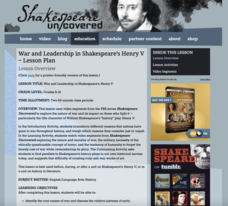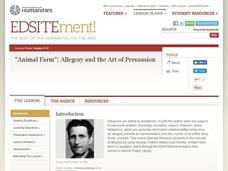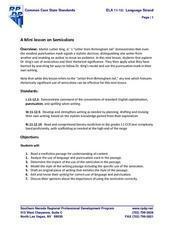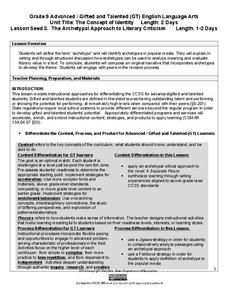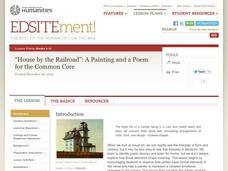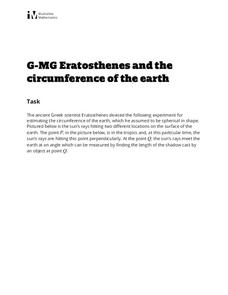Shakespeare Uncovered
War and Leadership in Shakespeare’s Henry V
“Compared to war all other forms of human endeavor shrink to insignificance.” “War is not healthy for children and other living things.” These two views of war, embodied in George Patton’s statement and Lorraine Schneider‘s famous 1966...
Curated OER
Persuasion and Parallel Structure
Discuss the definition of parallel structure with your high school class. In small groups, they read a section of "The Declaration of Independence" to identify examples of parallel structure. Each learner writes an essay explaining the...
National Endowment for the Humanities
Animal Farm: Allegory and the Art of Persuasion
Introduce your class members to allegory and propaganda with a series of activities designed to accompany a study of George Orwell's Animal Farm. Readers examine the text as an allegory, consider the parallels to collective farms and the...
New York City Department of Education
What Did I Do to Be so Black and Blue: How Did Jazz Influence Ralph Ellison's Invisible Man
How did jazz influence Ralph Ellison's Invisible Man? Class members read some of Ellison's non-fiction writings about blues and jazz, listen to records, watch videos, and engage in student-centered discussions. They then produce podcasts...
EngageNY
Grade 9 ELA Module 4, Unit 1, Lesson 28
As writers continue to revise their argument essays, the focus shifts to editing grammatical conventions, parallel structure, and varying syntax to add interest. After examining model sentences that demonstrate sentence variety, writers...
Southern Nevada Regional Professional Development Program
A Mini lesson on Semicolons
Dr. Martin Luther King, Jr.'s "Letter from Birmingham Jail" serves as an exemplar for a mini-lesson on semicolons. Working alone or in small groups, class members first circle all the semicolons in the letter, and then consider how this...
Penguin Books
A Teacher’s Guide to the Signet Classics Edition of Mary Shelley ’s Frankenstein
Contrary to popular belief, the monster's name in Mary Shelley's Frankenstein is not Frankenstein. A teacher's guide for the novel helps readers make sense of key details in the text, define vocabulary words, and discuss prominent...
Novelinks
The Adventures of Tom Sawyer: Cubing Strategy
The toss of a die determines what questions your pupils will answer in this lesson. Learners respond to questions based on Bloom's taxonomy, discussing The Adventures of Tom Sawyer with classmates along the way. They finish by writing up...
Curated OER
Tangerine: Cubing Strategy
Here's an activity that uses a reading comprehension strategy based on Bloom's taxonomy to focus readers' attention on key passages from Edward Bloor's Tangerine. Worthy of a place in your curriculum library.
The New York Times
Teaching Orwell and '1984’ with the New York Times
Doublethink and alternate facts? Big Brother and Facebook? 1984 and 2019? Sales of 1984 have surged and so has the use of George Orwell's dystopian classic in classrooms. Whether new to teaching the novel or a seasoned veteran you'll...
The Big Read
The Grapes of Wrath - Discussion & Writing Activities
Add a great resource to your collection of The Grapes of Wrath curriculum materials. A thorough packet contains loads of useful suggestions, whether you use the novel as an anchor text, as a reading circle option, or as independent reading.
Steppenwolf Arts Exchange
Fahrenheit 451: Study Guide
Here's a must-have packet for your curriculum library. If you are interested in Fahrenheit 451, if you are interested in Ray Bradbury, if you are interested in censorship, if you interested in programs that make a difference, then this...
Maryland Department of Education
The Concept of Identity Lesson 3: The Archetypal Approach to Literary Criticism
As class members continue their study of approaches to literary criticism, readers examine the symbolism and archetypal patterns in John Knowles' A Separate Peace, and how these parallels are used to develop a theme in the story.
Novelinks
The Winter’s Tale: Problematic Situation
Before beginning The Winter's Tale groups read and discuss a scenario that parallels the plot of Shakespeare's play. They then brainstorm possible solutions to the problem.
Curated OER
KWHL Questioning Strategy for Briar Rose
Whether new to the KWHL strategy or not readers of Briar Rose will benefit from the detailed procedures and templates designed for Jane Yolen’s novel. Links are provided for research into the Holocaust and activities reveal the many...
Novelinks
Zach’s Lie: Questioning Strategy – Cubing
Your class won't be a bunch of squares from using this well-rounded activity! Instead, they'll be expressing thoughtful questions using the cubing strategy. The class brainstorms questions of increasing rigor about Zach's Lie in the...
Shmoop
ELA.CCSS.ELA-Literacy.RL.9-10.5
Your students already know when they like a story and when they don't, but they may not know that the plots of these stories are shaping that opinion. Like all resources in this series, the two activities and quizzes provided here deal...
National Endowment for the Humanities
“House by the Railroad”: A Painting and a Poem for the Common Core
Introduce your class to ekphrastic poetry with an exercise that asks them to examine Edward Hooper's painting House by the Railroad and Edward Hirsch's poem "Edward Hopper and the House By the Railroad." After a close reading of the two...
Curated OER
People are People
Explore human diversity in this human rights lesson. Middle schoolers compare novels, speeches, videos, and short stories that promote diversity and basic human rights. They complete daily coursework as they read the selected literature...
Illustrative Mathematics
Eratosthenes and the Circumference of the Earth
The class gets to practice being a mathematician in ancient Greece, performing geometric application problems in the way of Eratosthenes. After following the steps of the great mathematicians, they then compare the (surprisingly...
Scholastic
Narrative Writing
If you're looking to start a unit based around narrative writing, make sure to consider this resource while you're planning. This book covers five topics: writing personal narratives, writing narratives about others, writing narratives...
Curated OER
Ordinary People: Cubing Strategy
Readers of Ordinary People employ a cubing strategy based on Bloom’s Taxonomy to analyze, from multiple perspectives, an excerpt from Chapter 10 of Judith Guest’s novel. The excerpt, a rationale and complete directions for the activity...
Curated OER
The Grapes of Wrath: QAR--Question/Answer Relationship
Chapter nine of John Steinbeck's The Grapes of Wrath provides the text for an exercise that asks readers to think deeply about the items the Joads left behind and what these items might represent.
Curated OER
Maniac Magee: Picture Book Strategy
Who would have thought to explore the concept of race through children's literature? After reading Bell Hooks' picture book, Skin Again, and chapter sixteen of Jerry Spinelli's Maniac Magee, class members consider whether skin color...


